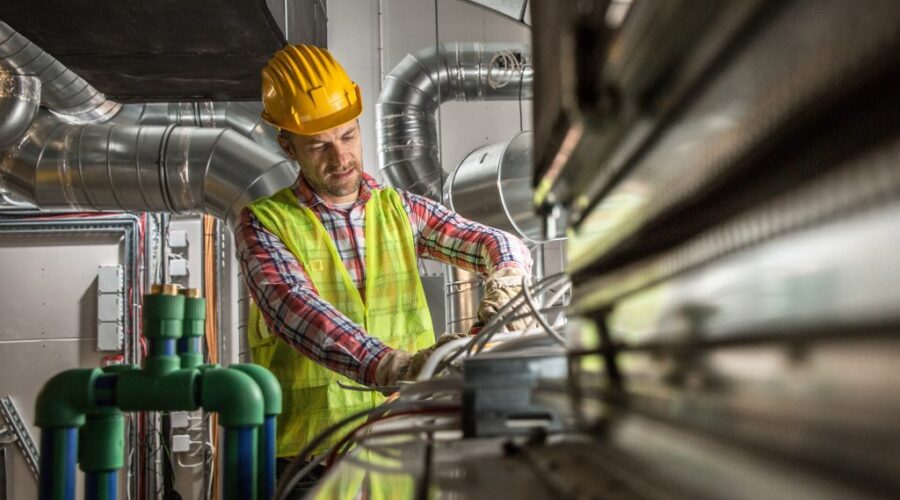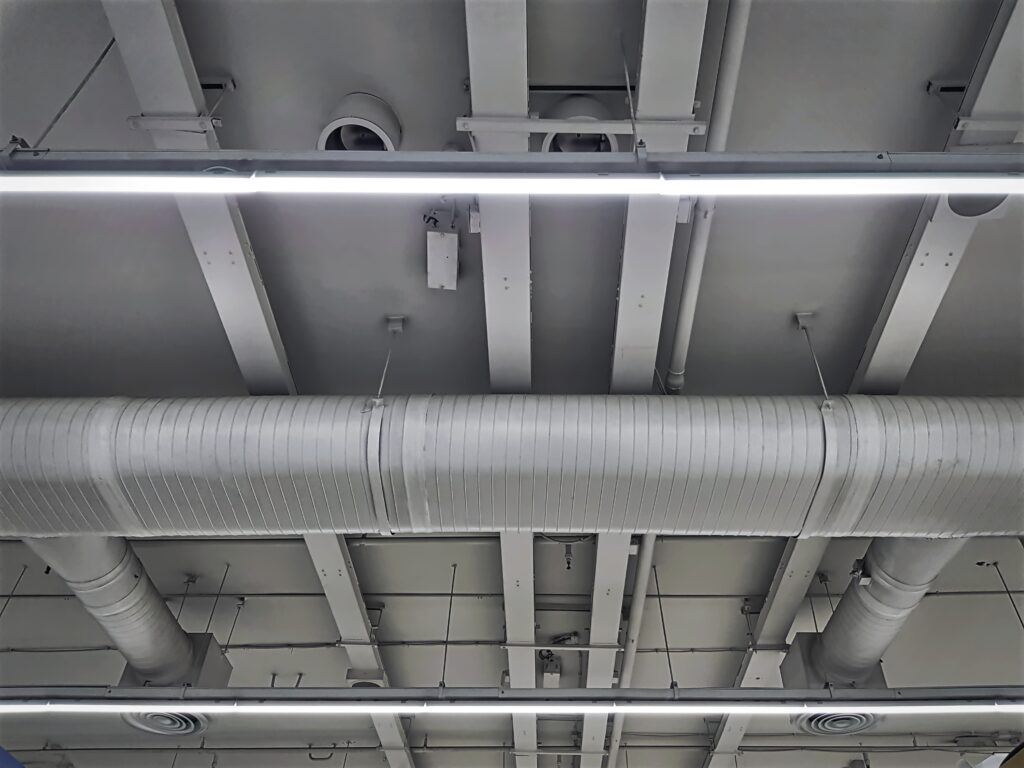Far too often, buildings intended to deliver the highest levels of energy efficiency, sustainability, and comfort are failing to live up to their potential. Testing, adjusting, and balancing (TAB) contractors diagnose these performance shortfalls, making sure a building works as it is designed to, whether it’s newly constructed or an existing edifice.
Farrell Flannery, managing director, Technical Systems Solutions & Measurements (TSSM), New York City, said that TAB is needed in a high-performance building because of the way that kind of building is typically designed.
“New construction, especially high-rise towers, is designed for optimum HVAC performance. It is critical that the systems are balanced exactly as they are designed. It is also a must for the design engineer to analyze how his or her design is functioning.”
Tom DeMusis, president and CEO, Wm. J. Donovan Co., Philadelphia, holds International Certification Board (ICB) and Testing, Adjusting, and Balancing Bureau (TABB) certifications. He also insisted TAB is essential to a high-performance building. “Balancing is even more critical in high performance buildings [HPBs] than in other buildings, where systems are less likely to be oversized, and ventilation rates are optimized.”
TAB offers high-performance buildings a wealth of potential improvements that can help keep tenants comfortable and happy.
Ron Landberg, department manager, MacDonald-Miller Facility Solutions, Seattle, holds National Environmental Balancing Bureau (NEBB) and TABB certifications. Landberg said capacity and efficiency testing makes certain “the system delivers expected performance outcomes, comfort, and efficiency at various levels of operation,” and pointed out buildings that are balanced are more comfortable and efficient, since they have fewer drafts and fewer simultaneous heating and cooling conflicts. “In an ever-changing market, where tenants move out constantly, the TAB service secures and effectively manages HVAC complaints, reduces energy costs, and delivers temperature control in all situations — all hallmarks of the high-performance building.”
If a high-performance building isn’t tested and balanced, however, it can negatively affect other parts of the building and its occupants. Nick White, president, ND White Engineering, Abilene, Texas, and chairman of the NEBB’s TAB committee, said, “Incorrect air and water flows are just part of the problem. Incorrect building pressures can prevent exterior doors from closing (excessive positive pressure) or make doors difficult to open (excessive negative pressure). Incorrect room pressures within the building can create both uncomfortable and unsafe conditions, including improper room air changes in labs and hospitals.”
TAB might be necessary for other reasons, too. Steve Garifo, service technician, building services div., McKenney’s Inc., Charlotte, North Carolina, said, when it comes to Leadership in Energy and Environmental Design (LEED) certification, air and water balancing are an important part of the process. He added, “Manufacturers may even require it for warranty purposes.”
James Rosier, vice president, Equal Air Balance Co. Inc., Orange, California, is ICB, TABB, and NEBB certified. Rosier, who also serves as NEBB chapter coordinator, said whether or not it’s a high-performance building, it’s important to explain the scope of the work to customers. “If you hire an air balance company, you don’t have as many callbacks if it is done correctly,” he said.
Mark Ellis Sr., president, Air Moving Equipment Co., Las Cruces, New Mexico, summed up what TAB work offers to a high-performance building, comparing it to taking care of a car. “It just makes common sense that the building would benefit, like a well-tuned automobile,” said Ellis Sr., who holds ICB/TABB certification. “They both have similar benefits. They will operate better, be more efficient, and be more comfortable to ride in or work in.”
Many builders and facility managers are already aware of the benefits that TAB work extends to a building. Numerous contractors said they still insist on discussing the advantages of TAB as well as the energy increase that results when TAB isn’t performed. Kevin Wilton, TABB-certified supervisor, Advanced Testing Balancing and Energy Consulting, Brooklyn, New York, said, “TAB work is important to building owners who are interested in renting the facility out at the highest price possible, and, at the same time, be operated at the least amount of energy cost. TAB contractors do the setup work that ensures the building owner is operating at the least amount of energy and that the building is comfortable.”
Landburg said, at MacDonald-Miller, staff explains TAB to customers by demonstrating the value, efficiency, and comfort the service provides. “We show completed reports and show them [clients] how the report becomes a roadmap and baseline of system performance.”
Bradley Sharp, TAB supervisor, MacDonald-Miller Solutions, added that it can be understood in car terms. “It’s like the first service for a new car,” Sharp said, who holds NEBB and TABB certifications. “You want to make sure somebody that is familiar with system fundamentals and operation checks it out.”
What’s in a TAB?
Besides adjusting a building’s air and water system to design conditions, White said TAB done well identifies three major types of problems:
1. Installation: improper duct and fittings, leakage, missing grilles and dampers, etc.
2. Equipment Problems: poorly performing, undersized, oversized, wrong speed, wrong voltages, etc.
3. Design issues. “We make it a point not to criticize an engineer’s design, but sometimes our design flows and pressures do not agree with the equipment schedule or simply cannot work as designed. We try to work with the engineer to understand intent and convey actual installation details and readings back from the field. Much of this information is not evident from a visual inspection only and not obvious until we put test instruments on the equipment,” he said.
Parts of the work that should be performed in every TAB project, according to White, are a “complete balance report of all air and water flows, tests of each piece of equipment, and a detailed deficiency list documenting all problems found during the TAB. Knowing what these items are and communicating them to the contractor before retainage is paid and the warranty expires is probably as important as the TAB itself to an owner. It can easily save thousands of dollars when an owner doesn’t have to pay twice for work he should have received in the first place. In addition, the AE [architect-engineer] and contractor may avoid the frustration of designing and building a good project only to damage an owner relationship because the building was never balanced.”
DeMusis agreed that a thorough review of the condition of the equipment and its operational capabilities should be part of each TAB job. “There’s little point in trying to balance a system that doesn’t function properly,” he commented.
Paul Jaeger, coordinator, environmental systems div., Mechanical Solutions Inc., St. Louis, holds ICB/TABB certification. He said that besides the TAB work itself, commissioning should also be done.
While a TAB project done well benefits the building’s systems, its owners and managers, and the people in the building, there are a variety of ways it can be done incorrectly.
DeMusis said the most common errors involve “using dampers and valves to control a system that’s running above what’s required to meet the design condition — wasting energy and resulting in a noisy system that’s likely to wear prematurely.”
Jaeger said that total system testing and seasonal testing are often done wrong. “If either one of those aren’t done correctly under peak conditions, the equipment/building will not function properly. It could cause building pressure problems.”
Other reasons TAB is commonly performed incorrectly include: the project is behind schedule and/or not given adequate time to provide a proper balance; poor equipment operation and nobody will fix it; pressure from an outside source to just get it done; not seeing the importance of the process/service, leading to ‘scope cut;’ systems are not complete or lack controls; failure to follow TABB protocol or a blasé attitude; and, often, control strategies are executed without getting input from the TAB contractor, said Sharp.
TAB also can be performed incorrectly because of who is carrying out the project.
Garifo said that most of the problems he’s seen are due to lack of education and job experience in TAB work.
Flannery commented that the mechanical contractor will often try to balance a building, but due to a lack of experience in properly balancing the system, it ends up that the system does not serve the end client’s needs.
And even if the work is performed by a TAB contractor, sometimes the work is done incorrectly due to elements beyond the TAB professional’s control, such as an incomplete project or a project not properly started up, said White. “But, just as often, bad work can be a result of unqualified persons on the job, improper supervision, technical incompetence, and perhaps even dishonesty. Again, like any other trade, an owner must find certified TAB professionals that have proven themselves competent and trustworthy.”
The bidding process is a point at which those who have put a job out for bid may find it prudent to vet those who want the job. “All TAB projects should require that all bidders on the project be able to prove its employees are qualified to do TAB work. Care must be taken that the low bidder is not automatically selected to do the TAB work on the project,” Wilton said.
“There are so-called TAB contractors who consistently come in as the low bidder because they intend to cut corners on the projects and/or submit false TAB reports that are fabricated, not measured. … This ends up causing utility costs to be above designed levels, and comfort levels suffer. The owner must then have expensive post-TAB work [done] to make his tenants happy, which decreases his profit margin,” he said.
But when TAB work is carried out correctly and thoroughly, it can make a positive difference in the equipment operations, building energy savings, and comfort and safety of the people in the building.
Flannery said TAB is important today, especially with the advanced technology that runs HVAC systems. “No matter how well it is designed, how well it is installed, and how well the controls work, it still has to be balanced by a qualified firm,” said Flannery. “The experienced TAB firm has the expertise to be familiar with all phases of the project, from design to operation.”
Publication date: 6/2/2014
https://www.achrnews.com/articles/126768-tab-analysis-critical-for-building-efficiency






